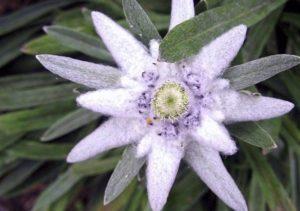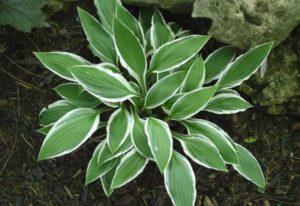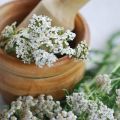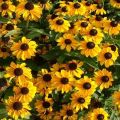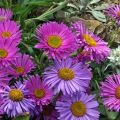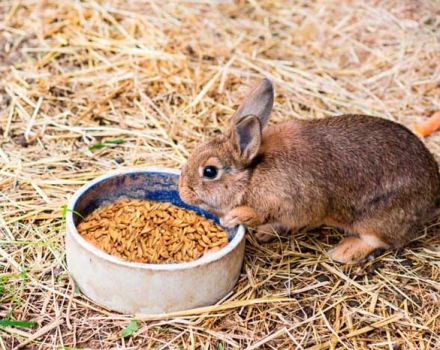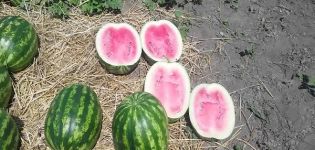Description of varieties of yarrow, planting, cultivation and care
Ornamental varieties of yarrow are planted in the garden. Large inflorescences and carved leaves go well with other flowering perennials. The herbaceous plant can grow in partial shade and on any soil. Yarrow is growing in popularity. It is increasingly grown on personal plots.
Content
- 1 general information
- 2 Types and varieties of yarrow
- 2.1 Yarrow noble
- 2.2 Yarrow
- 2.3 Yarrow meadowsweet
- 2.4 Yarrow ptarmica
- 2.5 Felted yarrow
- 2.6 Yarrow
- 2.7 Garden yarrow
- 2.8 Ornamental yarrow
- 2.9 Yarrow Pearl
- 2.10 Yarrow Cherry Queen
- 2.11 Yarrow Red Velvet
- 2.12 Yarrow paprika (paprika)
- 2.13 Terry Yarrow Dew Drop
- 2.14 Yarrow naked
- 2.15 Yarrow madison
- 2.16 Asian yarrow
- 2.17 Alpine yarrow
- 2.18 Yarrow agerata
- 2.19 Yarrow New Vintage Red
- 3 Planting and caring for yarrow
- 4 Yarrow propagation
- 5 Yarrow partners
general information
The yarrow has a well-developed rhizome consisting of branched rods. Shoots are straight, little branching, woody in the lower part, grow in height from 15 to 100 cm.The leaves are alternate, pinnately dissected, green, gray or gray-green.
Scutellum inflorescences form at the tops of the stems and bloom in mid-summer. They consist of a large number of small baskets (size 3-20 mm). The middle of the basket is formed by tubular bisexual yellow-gray flowers. They are framed by ligulate flowers and are characterized by a mixture of colors. The outer petals are white, pink, yellow, lilac.
Types and varieties of yarrow
The genus of yarrow is represented by 150 species. He belongs to the Astrov family. A perennial herb grows naturally in many regions of Russia. Breeders are working on the development of new decorative varieties. The height of the stem of the garden perennial is 20-120 cm, the color of the baskets is lemon, golden, white, pink.
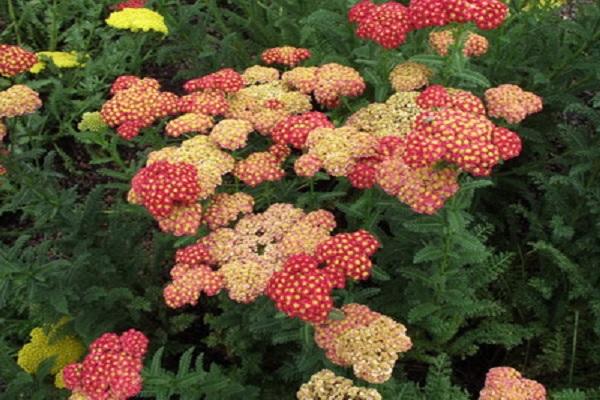
Yarrow noble
The species grows in the steppe, pine forest, on the mountain slopes. It can be found in Western Siberia, in the southern regions of Russia, in the foothills of the Caucasus. Perennial bushes are not striking in height, they do not exceed 70 cm.
The stems are covered with pinnately dissected gray-green leaves along the entire length. In the root zone, they are ovoid. In June, snow-white inflorescences bloom. They are dense, large.
View advantages:
- frost-resistant, not afraid of frost 30 ° C;
- does not creep;
- blooms early.

Yarrow
It occurs naturally in the Far East, in Japan, and grows in meadows. The stems are 60 cm long. They are covered with double-serrate, lanceolate leaves. The shape of the baskets is hemispherical, the color is white. A large-headed perennial species blooms in August.
Yarrow meadowsweet
Tavolgovaya perennial species is found in the Caucasus and Central Asia. The plant is high - 1.2 m. The stems are covered with openwork gray-green leaves. Flat corymbose inflorescences consist of small baskets (5 mm), formed by yellow tubular flowers and golden marginal flowers. Inflorescences reach 13 cm in cross-section, bloom in July.
For amateur floriculture, varieties are suitable:
- Parker;
- Schwellenburg;
- Moonshine.
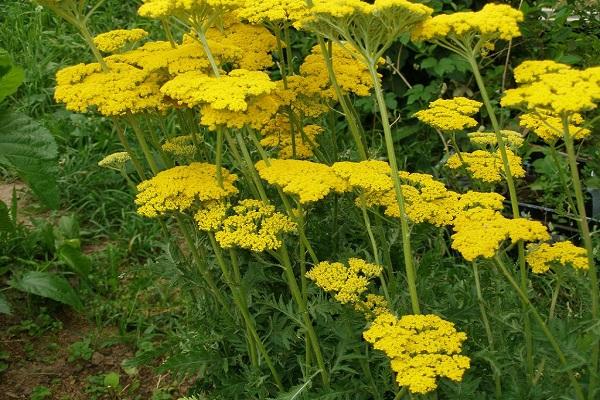
Yarrow ptarmica
The decorative species grows in the natural conditions of the European part of Russia, domesticated in the 16th century. In dry years, the stems grow up to 35-55 cm, under favorable weather conditions - up to 100 cm. The erect shoots of a herbaceous perennial are covered with pointed serrate leaves. The length of solid sheet plates is 2-6 cm.
Flowering can last 1-2 months. Thyroid inflorescences bloom at the end of June. They are assembled from baskets with a diameter of 10-17 mm. Terry varieties of ptarmik are grown in the gardens:
- Pearl Blapunkt;
- Perris White;
- Stephanie (new);
- Boulle de Neige.
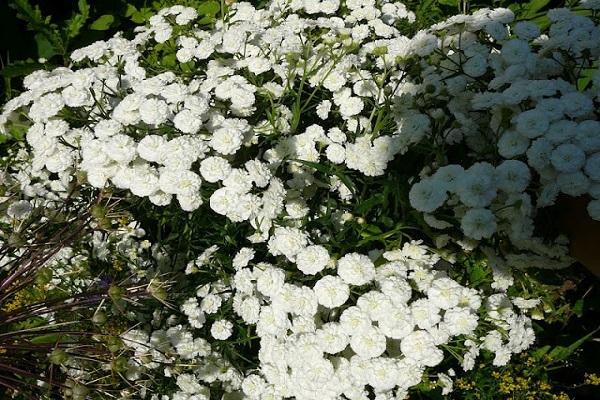
Felted yarrow
The species is found in Western Siberia and in the southern regions of Eastern Europe. Florists plant felt varieties in rock gardens. Low bushes (15 cm), growing, form a carpet. The diameter of one plant can be up to 45 cm.
Silvery leaves are pinnately dissected with pubescence. In winter, they stick to the ground, do not die off. Lemon-yellow baskets are collected in corymbose inflorescences. Their diameter reaches 7 cm. The Aurea variety is popular among amateur gardeners.
Yarrow
The variety is ubiquitous. It is used as a medicinal and ornamental plant. Stems are straight (0.8 m). The leaves are alternate, sessile at the top, with cuttings at the bottom. The leaf plates are pinnately dissected.
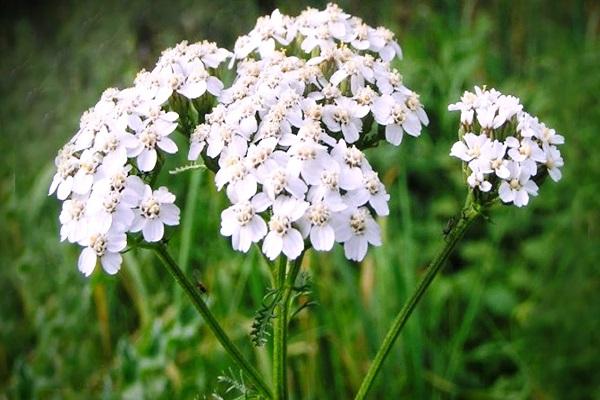
Baskets are small (7 mm), formed by tubular yellow flowers and ligulate pink, white or purple flowers. The variety blooms for almost 2 months. Inflorescences bloom in July, bloom on August 10-15.
Varieties are grown on personal plots:
- Terracotta;
- Serise Queen;
- White Beauty;
- Summervine.
Garden yarrow
Perennial golden yarrow is grown in the garden and winter greenhouses. Flowering shoots of tall varieties are used when drawing up bouquets. The yellow garden look looks especially impressive in group plantings. Garden varieties are used as dried flowers, long stalks are included in dry winter bouquets.
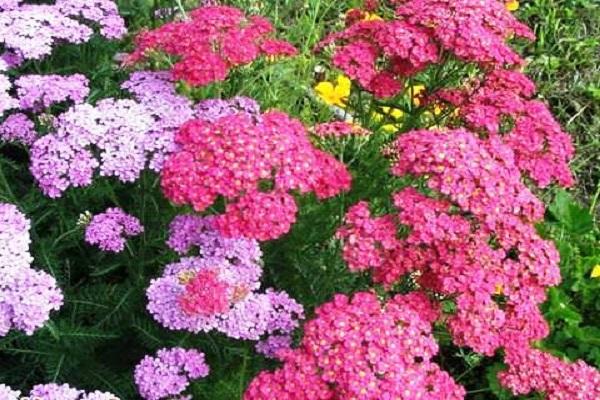
Ornamental yarrow
Ornamental varieties of herbaceous perennial were obtained in the course of breeding work. The main characteristics of cultural forms:
- stem length 70 cm;
- the size of the baskets is 3 mm;
- diameter of inflorescences 20 cm.
Yarrow Pearl
Early flowering is the main advantage of the variety. When sown with seeds, the herbaceous perennial blooms in the first year of life. Terry inflorescences resemble white pearls. They envelop compact bushes (65-75 cm) in a snow-white cloud.
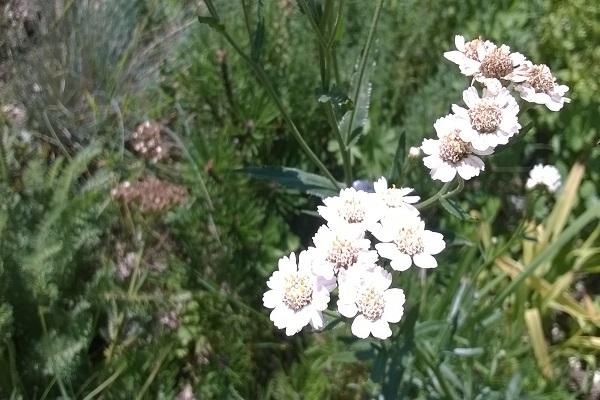
Yarrow Cherry Queen
Medium-sized perennial. Stems grow up to 80 cm per season. The plant has a strong root system. It grows rapidly, capturing territory. Inflorescences are corymbose cherry-red, bloom in August, consist of many small flowers.
Yarrow Red Velvet
Perennial height 80 cm. Prefers sun, but can grow in light partial shade. Carmine red flowers bloom in June. Flowering continues until August.
Yarrow paprika (paprika)
Refers to the species of yarrow. Blooms 45 days, the first red inflorescences bloom in June. The middle of the baskets is yellow. Stems 45-60 cm long, covered with alternate, pinnately dissected leaves. The variety winters well.
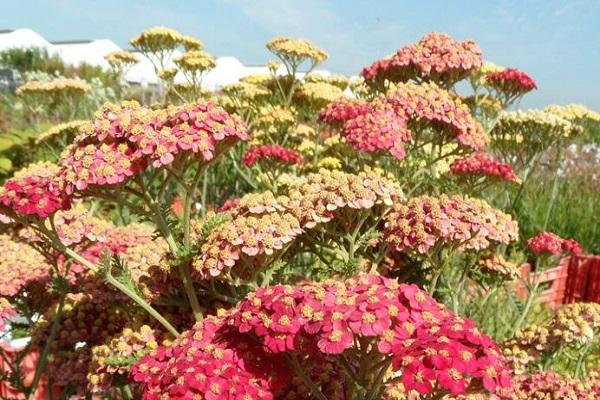
Terry Yarrow Dew Drop
The perennial remains decorative all summer long. It blooms luxuriously.Bushes 60 cm high during flowering are abundantly covered with snow-white inflorescences (12 cm), consisting of terry baskets. Flowering lasts from June to October.
Yarrow naked
The species is very rare. You can meet a perennial only in the Donetsk steppe. The length of erect, branched shoots is 20-40 cm. They are covered with separate, serrated leaves. The color of the baskets is yellow, they are collected in the apical inflorescences.
Yarrow madison
Garden perennial with straight stems 50-70 cm high, covered with beautiful openwork leaves. In July, dense inflorescences (15 cm) of different colors are formed on the tops of the shoots. Flowering lasts until August. Perennial winters well, can grow in partial shade.

Asian yarrow
Stunted view. The maximum stem length is 60 cm. In nature, the Asian yarrow grows on the coast of the Sea of Okhotsk. Blooms from July to August, pleases with beautiful purple inflorescences. They consist of small baskets (3 mm).
Alpine yarrow
A low-growing perennial (30-75 cm) with a short rhizome, straight, pubescent stems. Leaves are linear-lanceolate, sessile. The shape of the inflorescence is corymbose. It is formed by white semi-ovate baskets. Inflorescences bloom in July, flowering lasts until September.
Yarrow agerata
This species is used as a ground cover plant. The bushes, covered with light gray leaves (15 cm high), grow well on poor, rocky ground. A stunted, unpretentious perennial is planted on alpine slides and rockeries.
The perennial is decorative not only during flowering from July to August. Small bushes are good in spring and autumn. Herbaceous plants adorn narrow-lanceolate leaves with white pubescence. Snow-white baskets measuring 2.5 cm.
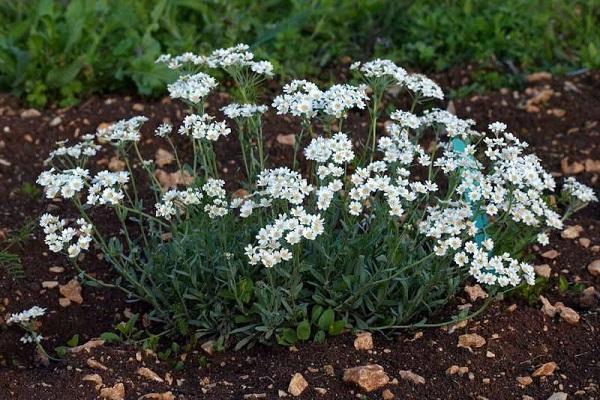
Yarrow New Vintage Red
The variety is recommended to be planted in sunny areas of the garden. It tolerates frosty winters (-29 ° C) well. Inflorescences bloom in June. Blooming New Vintage Red continues until August. Variety characteristics:
- height 30-35 cm;
- bush diameter 25-30 cm;
- the color of the baskets is red, the center is cream.
Planting and caring for yarrow
An ornamental crop grows on any type of soil, it develops better at pH values of 6-7 units. When choosing a place, take into account the photophilousness of the perennial and its aggressiveness. He quickly develops nearby territories.
Top dressing is carried out in the spring. Mineral fertilizers containing nitrogen, phosphorus, potassium are introduced. Organics are contraindicated for yarrow. In summer, the perennial is watered once a week, if there is no rain.
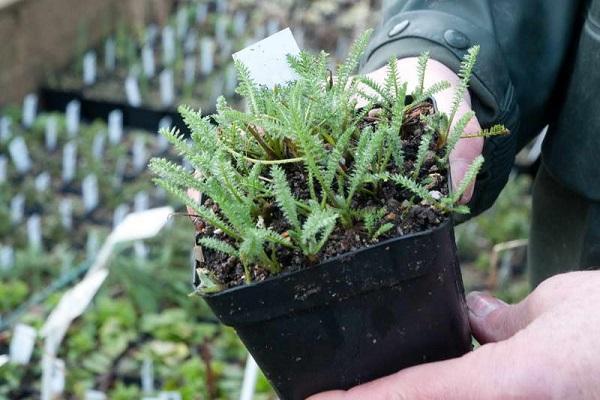
Once every 4 years, adult bushes are planted. Do it this spring. In the summer, wilted flower stalks are cut off. Timely pruning keeps the plant decorative, reduces the likelihood of self-seeding.
For medicinal purposes, flowering plants are cut, their upper part. Before frost, the stems are shortened to 10 cm, the soil is mulched with humus. In regions with little snow, a flower bed with perennials is covered with lutrasil.
Florists get new varieties by growing from seeds through sowing in open ground or seedlings. When to plant, see the seed bag. Seedlings are sown in early to mid-February. Already in April, the seedlings are ready for transplanting into open ground.
Yarrow propagation
You should not propagate a perennial with your seeds. Seedlings do not retain varietal characteristics, plants degenerate over time. Gardeners practice vegetative propagation methods. In autumn and spring - by dividing the bush, in summer - by green cuttings.
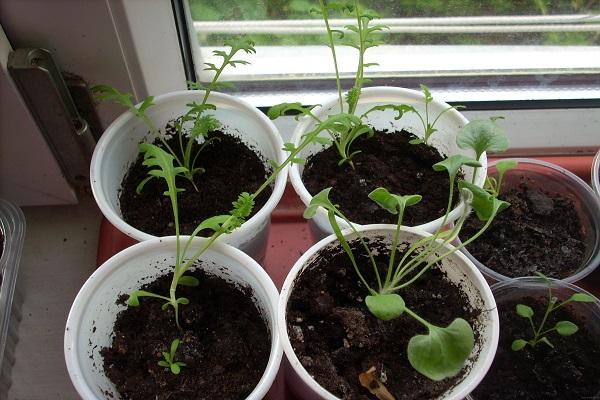
In summer, the tops of the shoots are cut. For rooting in partial shade, they equip a ridge. Sand, humus, peat are added to the soil. Cuttings are treated with a growth stimulator before planting. The seedlings of a herbaceous perennial are transplanted to a permanent place after the formation of roots.
Divide 3-year-old bushes in spring or fall.They dig them up by the roots, cut them into pieces and plant them in a new place. In one place, the bush grows for no more than 3 years.
Yarrow partners
In the garden, the herbaceous perennial fits well into garden compositions. There are many use cases. This allows a wide range of colors and different stem heights of varietal varieties.
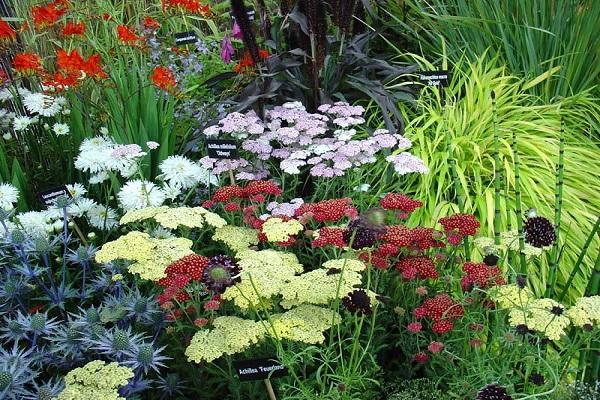
Sage can be considered an ideal neighbor. This culture is also unpretentious and remains decorative for a long time. Bright inflorescences look especially bright against a dark background of sage.
A varietal perennial is planted next to sun-loving flowering plants. The color of the flowers does not matter. Suitable neighbors are decorative tall cereals, rudbeckia, catnip, lavender.
All types of perennials have special properties. They enrich the soil with sulfur. This must be taken into account when choosing neighbors. Ornamental crops that respond well to sulfur compounds should be planted next to it.
